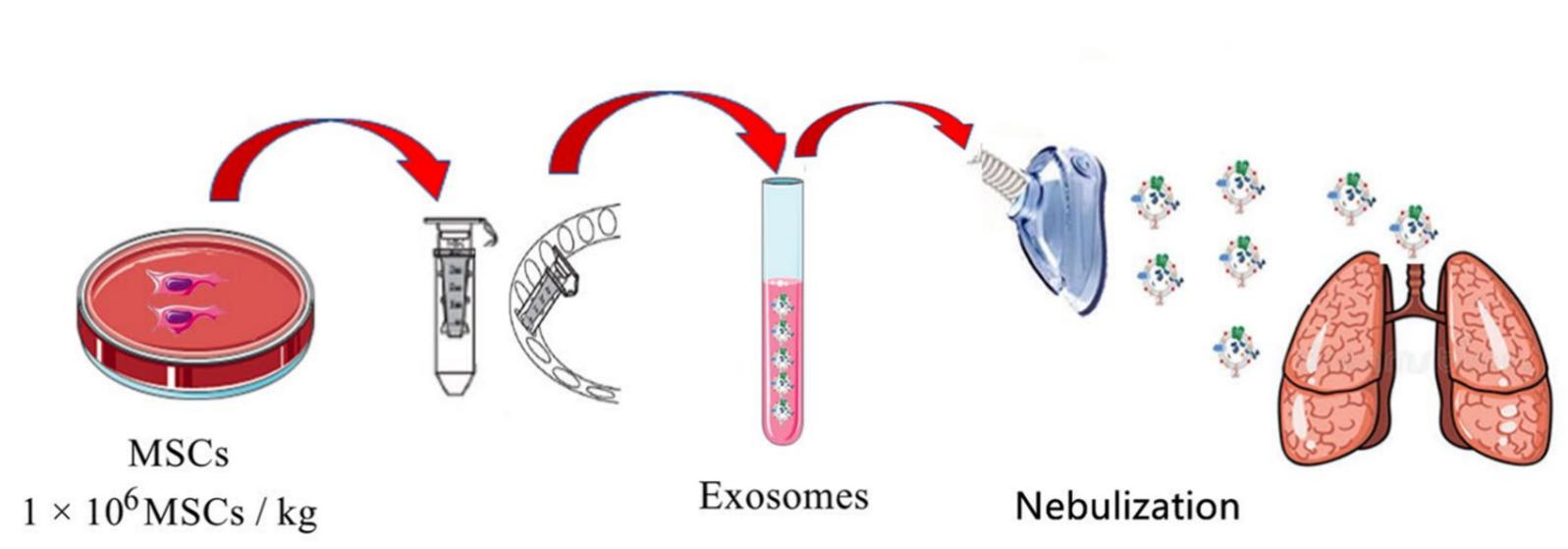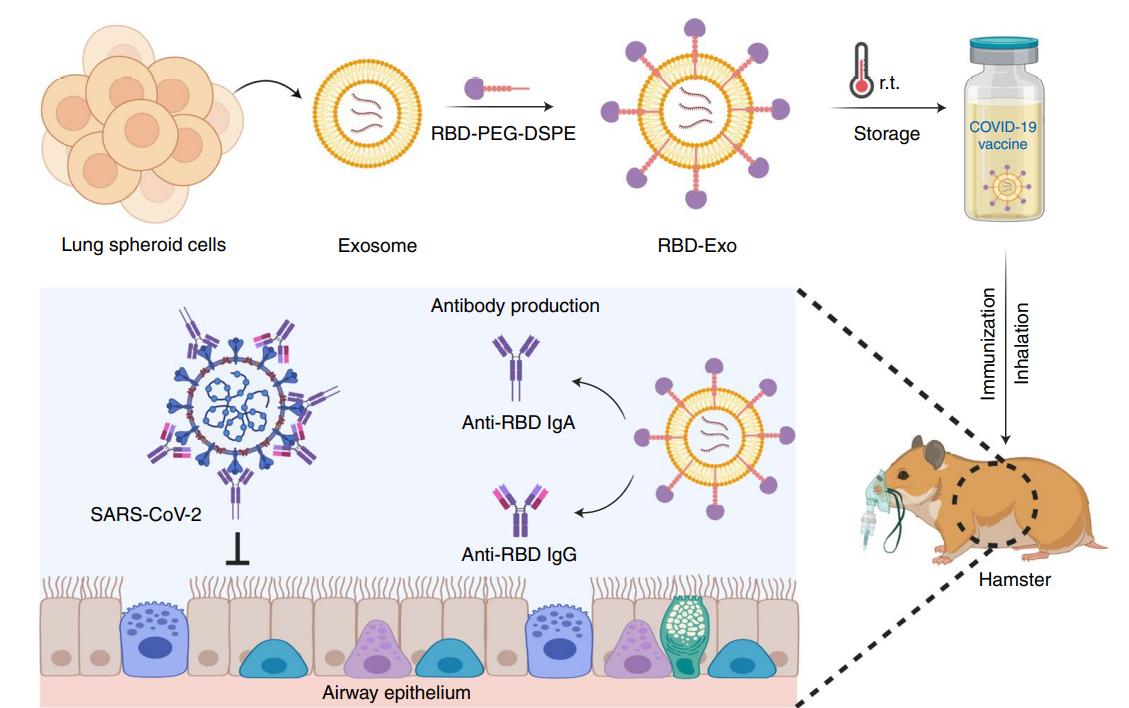Nebulized Inhalation-Fashioned Exosomes Advantage and Application
Traditional intravenous and oral drug delivery methods require large doses, limiting the expansion of drug applications. Inhalation administration of exosomes can maintain a high degree of stability before and after nebulization and requires only a small drug dose, breaking through the limitations of nebulized administration of traditional drugs and offering great advantages in the treatment of lung diseases. Creative Biolabs provides exosome-related research services with its advanced technology platform and professional team to promote the progress of research related to inhaled exosomes.
Nebulized Inhalation Exosomes Advantage
Conventional therapeutic drugs are expensive to produce, slow to develop, and not easy to optimize, and the traditional intravenous injection method requires a large dose of drugs, resulting in limitations in drug application. Nebulized inhalation is a new drug delivery method for nanomedicines such as exosomes, which is non-invasive and easy to operate, greatly reducing the pressure on medical care and saving medical resources. After nebulized inhalation, exosomes are absorbed by the lung epithelium and respiratory mucosa. With a large surface area, exosomes then rapidly enter the blood circulation. Inhalation administration avoids the first-pass effect of oral administration and is an excellent treatment modality for lung diseases. The nebulized exosomes can reach the subtle structures of the lung, such as the tiny bronchi and alveoli, thus delivering the active molecule directly to the target site. The increased local concentration of drug enrichment facilitates effective treatment with one-tenth the dosage of oral drugs and one-thirtieth the dosage of injectable drugs, with fewer side effects. For inhalation delivery, the exosome-based drug delivery system is transformed by the nebulizer into a dispersed mist or aerosol particle that is subjected to high pressure and force output from the nebulizer. It maintains the structural integrity and biological activity of the encapsulated drug during administration and is effectively deposited in the lungs. Exosomes as lipid membrane vesicles have biophysical properties such as high-pressure resistance, structural stability, and small molecular weight required for inhalation drug delivery, making it a promising drug delivery platform for nebulized inhalation.
 Fig.1 Schematic diagram of nebulization treatment of MSC (mesenchymal stem cell)-derived exosomes. (Chu, 2022)
Fig.1 Schematic diagram of nebulization treatment of MSC (mesenchymal stem cell)-derived exosomes. (Chu, 2022)
Nebulized Inhalation Exosomes Application
Nebulized inhalation therapy has been widely used as an essential treatment for respiratory-related diseases because of the advantages of rapid onset of action, good efficacy, few systemic adverse effects, and easy operation compared with oral, intramuscular, and intravenous drug administration modes since the drugs act directly on the target organs. Nebulized inhalation exosomes have shown promising therapeutic potential for bronchitis, laryngitis, pneumonia, and other respiratory inflammatory conditions. For example, mice with a pulmonary fibrosis model showed a reduction in damaged pulmonary fibrotic tissue and relief of lung inflammation after inhalation of exosomes derived from lung stem cells. As exosomes carry cytokines and miRNAs that regulate inflammatory and fibrotic pathways in the lung, nebulized inhalation of exosomes makes it possible for therapeutic effects. It is also observed that nebulized inhalation of MSC-derived exosomes can reduce the level of lung inflammation and significantly improve survival in a mouse model of bacterial-induced lung injury.
 Fig.2 Nebulized inhalation of LSC-secreted exosomes and soluble factors modulates alveolar repair and fibrosis in rats. (Dinh, 2020)
Fig.2 Nebulized inhalation of LSC-secreted exosomes and soluble factors modulates alveolar repair and fibrosis in rats. (Dinh, 2020)
In particular, for the current prevention and intervention of COVID-19, researchers have taken advantage of mesenchymal stem cell-derived exosomes modified with targeting proteins that inhibit the pulmonary immune system storm after nebulized inhalation administration, allowing for the systemic repair of COVID-19 damage to the lung. In addition, a vaccine consisting of pulmonary-derived exosomes bound to the RBD (receptor-binding domain) of the COVID-19 virus enhanced RBD retention in the respiratory tract and lung, induced RBD-specific IgG antibodies, mucosal IgA responses, and CD4+ and CD8+ T cells with a Th1-like cytokine expression profile in the lungs of mice, and reduced inflammatory infiltration after viral attack without acute allergic reactions or secondary anaphylactic reactions. More notably, compared to other nanoplatforms such as liposomes, lung-derived exosomes show increased intrapulmonary bioavailability of mRNA and proteins that could serve as ideal carriers for the inhalation treatment of respiratory diseases. Altogether, several studies have demonstrated that exosomes maintain positive therapeutic activity after nebulization and have been developed into nebulized inhaled drugs and vaccines with great promise and value.
 Fig.3 Inhalation of RBD-Exo vaccine protects hamster lungs. (Wang, 2022)
Fig.3 Inhalation of RBD-Exo vaccine protects hamster lungs. (Wang, 2022)
Exosomes with superior safety and pharmacokinetic properties for the treatment of respiratory and pulmonary diseases through nebulized inhalation. Nebulized inhaled exosomes deliver superior safety, pharmacokinetics, and modifiability in the treatment of respiratory and pulmonary diseases, and represent a new approach to the prevention and treatment of respiratory diseases as a cell-free technology. Creative Biolabs has built an innovative exosome platform to provide exosome-related research services to assist in studies related to nebulized inhaled exosomes. Please contact us with your interest.
References
-
Chu, M.; et al. Nebulization therapy with umbilical cord mesenchymal stem cell-derived exosomes for COVID-19 pneumonia. Stem Cell Rev Rep. 2022, 18(6): 2152-2163.
-
Dinh, P.C.; et al. Inhalation of lung spheroid cell secretome and exosomes promotes lung repair in pulmonary fibrosis. Nat Commun. 2020, 11(1): 1064.
-
Wang, Z.; et al. Exosomes decorated with a recombinant SARS-CoV-2 receptor-binding domain as an inhalable COVID-19 vaccine. Nat Biomed Eng. 2022, 6(7): 791-805.
For Research Use Only. Cannot be used by patients.
Related Services:

 Fig.1 Schematic diagram of nebulization treatment of MSC (mesenchymal stem cell)-derived exosomes. (Chu, 2022)
Fig.1 Schematic diagram of nebulization treatment of MSC (mesenchymal stem cell)-derived exosomes. (Chu, 2022)
 Fig.2 Nebulized inhalation of LSC-secreted exosomes and soluble factors modulates alveolar repair and fibrosis in rats. (Dinh, 2020)
Fig.2 Nebulized inhalation of LSC-secreted exosomes and soluble factors modulates alveolar repair and fibrosis in rats. (Dinh, 2020)
 Fig.3 Inhalation of RBD-Exo vaccine protects hamster lungs. (Wang, 2022)
Fig.3 Inhalation of RBD-Exo vaccine protects hamster lungs. (Wang, 2022)









